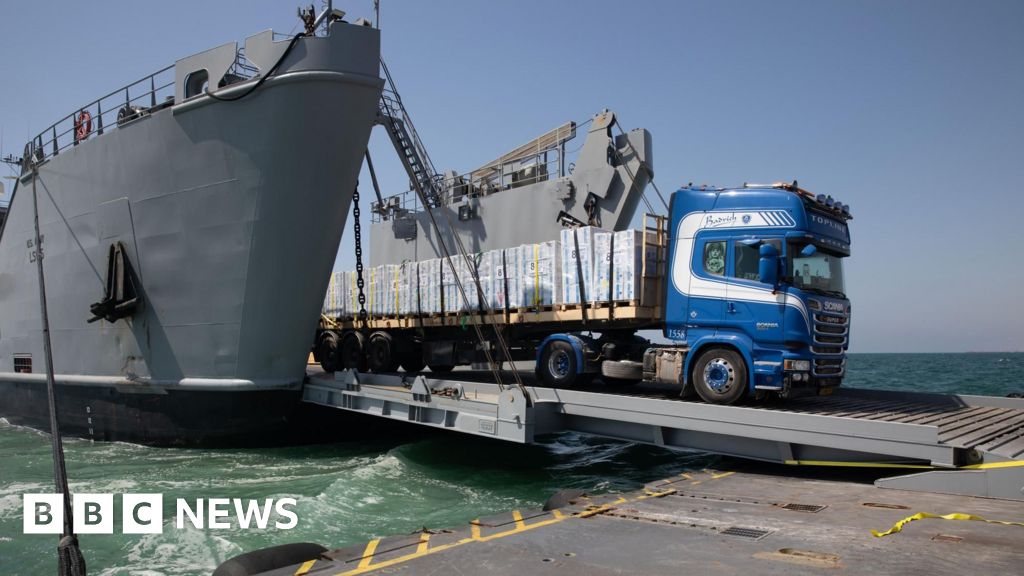The U.S. military has ended its mission to operate a temporary floating dock to deliver more aid to the Gaza Strip after being beset by weather, technical and security issues.
The deputy commander of Central Command said the supplies from Cyprus will now be transported by U.S. ships to the Israeli port of Ashdod and then trucked through Israeli-controlled crossings to northern Gaza.
Lt. Gen. Brad Cooper insisted the terminal had resulted in a “surge” in aid deliveries, noting that more than 9,000 tons of supplies had been delivered in two months.
However, the system only operated for about 20 days and was out of service due to bad weather on June 28.
The United Nations and other humanitarian organizations say the aid delivered through the terminal represents only a small fraction of the aid needed by Gaza’s 2.2 million Palestinians. They say 500 truckloads of aid and commercial supplies are needed every day, equivalent to 10,000 tons.
They have also consistently said – and the United States has acknowledged – that the most effective and efficient way to get aid into Gaza is by land.
Gen. Cooper told reporters that the dock mission was “an unprecedented operation in history to provide assistance to an active war zone without any U.S. military presence.”
He said: “Our assessment is that the temporary terminal has achieved the desired effect, allowing a large amount of aid to be poured into Gaza and ensuring that the aid can quickly reach the civilians in Gaza.”
He also considered the mission cost-effective, saying it would cost less than the original estimate of $230m (£177m).
The admiral said Israel fully supports the U.S. decision to end the terminal mission and “transition” to the port of Ashdod, just 30 kilometers (19 miles) north of Gaza.
“The main challenges we currently face in Gaza are insecurity and lawlessness, which hinder the distribution of aid once it enters Gaza and at border crossings,” said Sonali Coder of USAID’s Bureau of Humanitarian Assistance. “
When the terminal began operations in mid-May, U.S. officials said it would remain in place until August or September.
But after stormy weather in late May, the four landing craft involved in the operation broke free and washed ashore. Parts of the dock also had to be transported to Ashdod for repairs.
The entire building had to be moved to Ashdod three times over the next month due to bad weather and maintenance before the U.S. military decided to end the mission.
The United States was also forced to deny false reports on social media that Israel had used the terminal to conduct a hostage rescue mission in central Gaza on June 8.
However, due to security concerns, the United Nations World Food Program stopped collecting aid from the waiting area next to the dock, causing thousands of pallets of supplies to pile up. Eventually, contractors were hired to move the aid to warehouses before it spoiled.
Last week, U.S. President Joe Biden expressed frustration with the dock mission, saying: “I hope this mission will be more successful.”
Biden announced that the terminal would be built in March in response to a United Nations-backed assessment that warned of “imminent” famine in northern Gaza.
The latest assessment in late June said available evidence did not suggest famine was occurring there.citing an increase in the amount of food and other aid allowed in.
However, it warned that 495,000 people in Gaza still faced “catastrophic levels” of hunger, with a “high risk” of famine as long as the war between Israel and Hamas continued and humanitarian access was restricted. will persist.
U.N. officials blame the situation on Israeli military restrictions on aid deliveries, ongoing hostilities and a breakdown in law and order.
Israel insists there are no limits on the amount of aid that can be sent to and across Gaza and accuses U.N. agencies of failing to distribute supplies. It also accuses Hamas of stealing aid, which the group denies.

